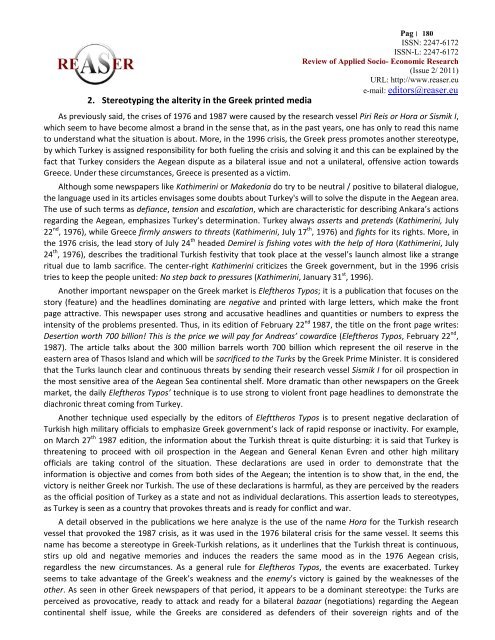Volume 2, ISSUE2/2011 - Review of Applied Socio-Economic ...
Volume 2, ISSUE2/2011 - Review of Applied Socio-Economic ...
Volume 2, ISSUE2/2011 - Review of Applied Socio-Economic ...
Create successful ePaper yourself
Turn your PDF publications into a flip-book with our unique Google optimized e-Paper software.
2. Stereotyping the alterity in the Greek printed mediaPag׀ 180 ISSN: 2247-6172ISSN-L: 2247-6172<strong>Review</strong> <strong>of</strong> <strong>Applied</strong> <strong>Socio</strong>- <strong>Economic</strong> Research(Issue 2/ <strong>2011</strong>)URL: http://www.reaser.eue-mail: editors@reaser.euAs previously said, the crises <strong>of</strong> 1976 and 1987 were caused by the research vessel Piri Reis or Hora or Sismik I,which seem to have become almost a brand in the sense that, as in the past years, one has only to read this nameto understand what the situation is about. More, in the 1996 crisis, the Greek press promotes another stereotype,by which Turkey is assigned responsibility for both fueling the crisis and solving it and this can be explained by thefact that Turkey considers the Aegean dispute as a bilateral issue and not a unilateral, <strong>of</strong>fensive action towardsGreece. Under these circumstances, Greece is presented as a victim.Although some newspapers like Kathimerini or Makedonia do try to be neutral / positive to bilateral dialogue,the language used in its articles envisages some doubts about Turkey's will to solve the dispute in the Aegean area.The use <strong>of</strong> such terms as defiance, tension and escalation, which are characteristic for describing Ankara’s actionsregarding the Aegean, emphasizes Turkey’s determination. Turkey always asserts and pretends (Kathimerini, July22 nd , 1976), while Greece firmly answers to threats (Kathimerini, July 17 th , 1976) and fights for its rights. More, inthe 1976 crisis, the lead story <strong>of</strong> July 24 th headed Demirel is fishing votes with the help <strong>of</strong> Hora (Kathimerini, July24 th , 1976), describes the traditional Turkish festivity that took place at the vessel’s launch almost like a strangeritual due to lamb sacrifice. The center-right Kathimerini criticizes the Greek government, but in the 1996 crisistries to keep the people united: No step back to pressures (Kathimerini, January 31 st , 1996).Another important newspaper on the Greek market is Eleftheros Typos; it is a publication that focuses on thestory (feature) and the headlines dominating are negative and printed with large letters, which make the frontpage attractive. This newspaper uses strong and accusative headlines and quantities or numbers to express theintensity <strong>of</strong> the problems presented. Thus, in its edition <strong>of</strong> February 22 nd 1987, the title on the front page writes:Desertion worth 700 billion! This is the price we will pay for Andreas’ cowardice (Eleftheros Typos, February 22 nd ,1987). The article talks about the 300 million barrels worth 700 billion which represent the oil reserve in theeastern area <strong>of</strong> Thasos Island and which will be sacrificed to the Turks by the Greek Prime Minister. It is consideredthat the Turks launch clear and continuous threats by sending their research vessel Sismik I for oil prospection inthe most sensitive area <strong>of</strong> the Aegean Sea continental shelf. More dramatic than other newspapers on the Greekmarket, the daily Eleftheros Typos’ technique is to use strong to violent front page headlines to demonstrate thediachronic threat coming from Turkey.Another technique used especially by the editors <strong>of</strong> Elefttheros Typos is to present negative declaration <strong>of</strong>Turkish high military <strong>of</strong>ficials to emphasize Greek government’s lack <strong>of</strong> rapid response or inactivity. For example,on March 27 th 1987 edition, the information about the Turkish threat is quite disturbing: it is said that Turkey isthreatening to proceed with oil prospection in the Aegean and General Kenan Evren and other high military<strong>of</strong>ficials are taking control <strong>of</strong> the situation. These declarations are used in order to demonstrate that theinformation is objective and comes from both sides <strong>of</strong> the Aegean; the intention is to show that, in the end, thevictory is neither Greek nor Turkish. The use <strong>of</strong> these declarations is harmful, as they are perceived by the readersas the <strong>of</strong>ficial position <strong>of</strong> Turkey as a state and not as individual declarations. This assertion leads to stereotypes,as Turkey is seen as a country that provokes threats and is ready for conflict and war.A detail observed in the publications we here analyze is the use <strong>of</strong> the name Hora for the Turkish researchvessel that provoked the 1987 crisis, as it was used in the 1976 bilateral crisis for the same vessel. It seems thisname has become a stereotype in Greek-Turkish relations, as it underlines that the Turkish threat is continuous,stirs up old and negative memories and induces the readers the same mood as in the 1976 Aegean crisis,regardless the new circumstances. As a general rule for Eleftheros Typos, the events are exacerbated. Turkeyseems to take advantage <strong>of</strong> the Greek’s weakness and the enemy’s victory is gained by the weaknesses <strong>of</strong> theother. As seen in other Greek newspapers <strong>of</strong> that period, it appears to be a dominant stereotype: the Turks areperceived as provocative, ready to attack and ready for a bilateral bazaar (negotiations) regarding the Aegeancontinental shelf issue, while the Greeks are considered as defenders <strong>of</strong> their sovereign rights and <strong>of</strong> the








